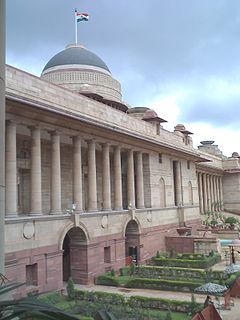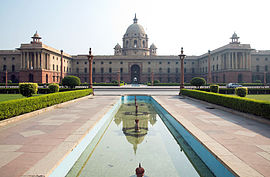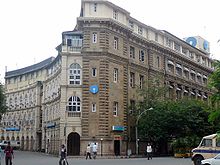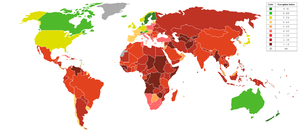
Government of India
Background to the schools Wikipedia
SOS Children have produced a selection of wikipedia articles for schools since 2005. Click here to find out about child sponsorship.
The Government of India, officially known as the Union Government, and also known as the Central Government, was established by the Constitution of India, and is the governing authority of the union of 28 states and seven union territories, collectively called the Republic of India. It is seated in New Delhi, the capital of India.
The government comprises three branches:
- the executive,
- the legislative and
- the judiciary.
The head of the executive branch is the President,and exercises his or her power directly or through officers subordinate to him / her.
The legislative branch or the Parliament consists of the lower house, the Lok Sabha, and the upper house, the Rajya Sabha, as well as the President.
The judicial branch has the Supreme Court at its apex, 21 High Courts, and numerous civil, criminal and family courts at the district level. India is the largest democracy in the world.
The basic civil and criminal laws governing the citizens of India are set down in major parliamentary legislation, such as the Civil Procedure Code, the Indian Penal Code, and the Criminal Procedure Code. The union and individual state governments consist of executive, legislative and judicial branches. The legal system as applicable to the federal and individual state governments is based on the English Common and Statutory Law. India accepts International Court of Justice jurisdiction with several reservations. By the 73rd and 74th amendments to the constitution, the Panchayat Raj system has been institutionalized for local governance.
The legislature is the Parliament. It is bicameral, consisting of two houses:
- the directly elected 552-member Lok Sabha ("House of the People"), the lower house, and
- the 245-member indirectly elected and appointed Rajya Sabha ("Council of States"), the upper house.
The Parliament enjoys parliamentary supremacy. All the members of the Council of Ministers as well as the President are members of Parliament. If they are not, they must be elected within a period of six months from the time they assume their respective office. The Prime Minister and the Council of Ministers are responsible to the Lok Sabha collectively.
Collective responsibility
The Prime Minister and the Council of Ministers are jointly accountable to the Lok Sabha. If there is a policy failure or lapse on the part of the government, all the members of the council are jointly responsible. If a vote of no confidence is passed against the government, then all the ministers headed by the Prime Minister have to resign.
Executive branch
The executive branch of government is the part of government that has sole authority and responsibility for the daily administration of the state bureaucracy. The division of power into separate branches of government is central to the republican idea of the separation of powers. The separation of powers system is designed to distribute authority away from the executive branch – an attempt to preserve individual liberty in response to tyrannical leadership throughout history.
President
The executive power is vested on mainly the President of India by Article 53 (1) of the constitution. The President enjoys all constitutional powers and exercises them directly or through officers subordinate to him as per the aforesaid Article 53(1).The President is to act in accordance with aid and advise tendered by the head of government ( Prime Minister of India) and his or her Council of Ministers (the cabinet) as described in Article 74 (Constitution of India).
The Council of Ministers remains in power during the 'pleasure' of the President. However, In practice the Council of Ministers must retain the support of the Lok Sabha. If a President were to dismiss the Council of Ministers on his or her own initiative, it might trigger a constitutional crisis. Thus, in practice, the Council of Ministers cannot be dismissed as long as it commands the support of a majority in the Lok Sabha.
The President is responsible for making a wide variety of appointments. These include:
- Governors of States
- The Chief Justice, other judges of the Supreme Court and High Courts of India
- The Attorney General
- The Comptroller and Auditor General
- The Chief Election Commissioner and other Election Commissioners
- The Chairman and other Members of the Union Public Service Commission
- The President's Officer
- The Cabinet Secretary, whose position is equivalent to the Ministers in Central Government. His work is to facilitate smooth transaction of business in Ministries/ Departments of the Government. The Secretariat held by Cabinet Secretary is termed as Cabinet Secretariat and assists in decision-making in Government by ensuring Inter-Ministerial coordination, ironing out differences amongst Ministries/ Departments and evolving consensus through the instrumentality of the standing/ adhoc Committees of Secretaries.
- Ambassadors and High Commissioners to other countries
The President also receives the credentials of Ambassadors and High Commissioners from other countries.
The President is de jure the Commander in Chief of the Indian Armed Forces.
The President of India can grant a pardon to or reduce the sentence of a convicted person for one time, particularly in cases involving punishment of death. The decisions involving pardoning and other rights by the President are independent of the opinion of the Prime Minister or the Lok Sabha majority. In most other cases, however, the President exercises his or her executive powers on the advice of the Prime Minister.
Vice President
The Vice-President of India is the second-highest ranking government official in the executive branch of the Government of India, following the President. The Vice-President also has the legislative function of acting as the Chairman of the Rajya Sabha.
Cabinet, executive departments and agencies
The Cabinet of India includes the Prime Minister and 35 Cabinet Ministers. Each Minister must be a member of one of the houses of India's Parliament. The Cabinet is headed by the Cabinet Secretary, who is also acting as the head of the Indian Administrative Service. Other Ministers are categorized as Union Cabinet Ministers, who are heads of the various Ministries; Ministers of State, who are junior members who report directly to one of the Cabinet Ministers, often overseeing a specific aspect of government; and Junior Ministers of State (Independent Charges), which do not report to a Cabinet Minister.
Judicial branch
India's independent judicial system began under the British, and its concepts and procedures resemble those of Anglo-Saxon countries. The Supreme Court of India consists of a Chief Justice and 30 associate justices, all appointed by the President on the advice of the Chief Justice of India. The jury trials were abolished in India in early 1960s, after the famous case KM Nanavati v State of Maharashtra, for reasons of being vulnerable to media and public pressure, as well as to being misled.
Unlike its US counterpart, the Indian justice system consists of a unitary system at both state and federal level. The judiciary consists of the Supreme Court of India, High Courts of India at the state level, and District Courts and Sessions Courts at the district level.
Supreme Court
The Supreme Court of India has original jurisdiction, appellate jurisdiction and advisory jurisdiction. Its exclusive original jurisdiction extends to any dispute between the Government of India and one or more states, or between the Government of India and any state or states on one side and one or more states on the other, or between two or more states, if and insofar as the dispute involves any question (whether of law or of fact) on which the existence or extent of a legal right depends.
In addition, Article 32 of the Indian Constitution gives an extensive original jurisdiction to the Supreme Court in regard to enforcement of fundamental rights. It is empowered to issue directions, orders or writs, including writs in the nature of habeas corpus, mandamus, prohibition, quo warranto and certiorari to enforce them. The Supreme Court has been conferred with power to direct transfer of any civil or criminal case from one State High Court to another State High Court, or from a court subordinate to another State High Court.
Public interest litigation (PIL)
Although the proceedings in the Supreme Court arise out of the judgments or orders made by the subordinate courts, of late the Supreme Court has started entertaining matters in which interest of the public at large is involved, and the Court may be moved by any individual or group of persons either by filing a Writ Petition at the Filing Counter of the Court, or by addressing a letter to Hon'ble The Chief Justice of India highlighting the question of public importance for invoking this jurisdiction.
Civil service
The Civil Services of India is the civil service and the permanent bureaucracy of the Government of India. The executive decisions are implemented by the Indian civil servants. Civil servants are employees of the Government of India and not Parliament of India. Not all employees of the Government of India are civil servants.
In parliamentary democracy of India, the ultimate responsibility for running the administration rests with the elected representatives of the people which are the ministers. These ministers are accountable to the legislatures which are also elected by the people on the basis of universal adult franchise. The ministers are indirectly responsible to the people themselves. But the handful of ministers cannot be expected to deal personally with the manifold problems of modern administration. Thus the ministers lay down the policy and it is for the civil servants to carry out this policy.
Cabinet Secretary
The Cabinet Secretary of India is the most senior civil servant in the country. The Cabinet Secretary is the Ex-Officio and Chairman of the Civil Services Board of the Republic of India; the chief of the Indian Administrative Service and head of all civil services under the rules of business of the Government of India. The Cabinet Secretary is arguably India's most powerful bureaucrat and right hand of Prime Minister of India.
The Cabinet Secretariat is responsible for the administration of the Government of India Transaction of Business Rules, 1961 and the Government of India Allocation of Business Rules 1961, facilitating smooth transaction of business in Ministries/Departments of the Government by ensuring adherence to these rules. The Secretariat assists in decision-making in Government by ensuring Inter-Ministerial coordination, ironing out differences amongst Ministries/Departments and evolving consensus through the instrumentality of the standing/ad hoc Committees of Secretaries. Through this mechanism new policy initiatives are also promoted.
The Cabinet Secretariat ensures that the President of India, the Vice-President and Ministers are kept informed of the major activities of all Departments by means of a monthly summary report of their activities. Management of major crisis situations in the country and coordinating activities of the various Ministries in such a situation is also one of the functions of the Cabinet Secretariat.
Elections and voting
India has a quasi federal government, with elected officials at the federal (national), state and local levels. On a national level, the head of government, the Prime Minister, is elected in-directly by the people, through a general election where the leader of the majority winning party is selected to be the Prime Minister. All members of the federal legislature, the Parliament, are directly elected. Elections in India take place every five years by universal adult suffrage.
State and local governments
State governments in India are the governments ruling States of India and the chief minister heads the state government.Power is divided between central government and state governments. State government's legislature is bicameral in 6 states and unicameral in the rest. Lower house is elected with 5 years term, while in upper house 1/3 of the total members in the house gets elected every 2 years with 6 year term.
Local government function at the basic level.It is the third level of government apart from central and state governments.It consists of panchayats in rural areas and municipalities in urban areas .They are elected directly or indirectly by the people.
Finance
Taxation
India has a three-tier tax structure, wherein the constitution empowers the union government to levy income tax, tax on capital transactions ( wealth tax, inheritance tax), sales tax, service tax, customs and excise duties and the state governments to levy sales tax on intrastate sale of goods, tax on entertainment and professions, excise duties on manufacture of alcohol, stamp duties on transfer of property and collect land revenue (levy on land owned). The local governments are empowered by the state government to levy property tax and charge users for public utilities like water supply, sewage etc. More than half of the revenues of the union and state governments come from taxes, of which 3/4 come from direct taxes. More than a quarter of the union government's tax revenues is shared with the state governments.
The tax reforms, initiated in 1991, have sought to rationalise the tax structure and increase compliance by taking steps in the following directions:
- Reducing the rates of individual and corporate income taxes, excises, customs and making it more progressive
- Reducing exemptions and concessions
- Simplification of laws and procedures
- Introduction of permanent account number (PAN) to track monetary transactions
- 21 of the 28 states introduced value added tax (VAT) on 1 April 2005 to replace the complex and multiple sales tax system
The non-tax revenues of the central government come from fiscal services, interest receipts, public sector dividends, etc., while the non-tax revenues of the States are grants from the central government, interest receipts, dividends and income from general, economic and social services.
Inter-state share in the federal tax pool is decided by the recommendations of the Finance Commission to the President.
Total tax receipts of Centre and State amount to approximately 18% of national GDP. This compares to a figure of 37–45% in the OECD.
Central Board of Direct Taxes
The Central Board of Direct Taxes (CBDT) is a part of the Department of Revenue in the Ministry of Finance, Government of India. The CBDT provides essential inputs for policy and planning of direct taxes in India and is also responsible for administration of the direct tax laws through Income Tax Department. The CBDT is a statutory authority functioning under the Central Board of Revenue Act, 1963.It is India's official Financial Action Task Force on Money Laundering (FATF) .The Central Board of Revenue as the Department apex body charged with the administration of taxes came into existence as a result of the Central Board of Revenue Act, 1924. Initially the Board was in charge of both direct and indirect taxes. However, when the administration of taxes became too unwieldy for one Board to handle, the Board was split up into two, namely the Central Board of Direct Taxes and Central Board of Excise and Customs with effect from 1.1.1964. This bifurcation was brought about by constitution of the two Boards u/s 3 of the Central Boards of Revenue Act, 1963.
Organizational structure of the Central Board of Direct Taxes
The CBDT is headed by Chairman and also comprises six members, all of whom are ex officio Special Secretary to Government of India.The Investigation Division of the Central Board of Direct Taxes is also headed by a member of the CBDT.
The Chairman and Members of CBDT are selected from Indian Revenue Service (IRS), a premier civil service of India, whose members constitute the top management of Income Tax Department and other various departments.
General budget
The Finance minister of India presents the annual union budget in the Parliament on the last working day of February. The budget has to be passed by the Lok Sabha before it can come into effect on 1 April, the start of India's fiscal year. The Union budget is preceded by an economic survey which outlines the broad direction of the budget and the economic performance of the country for the outgoing financial year. This economic survey involves all the variousNGOs, women organizations, business people, old people associations etc.
The 2009 Union budget of India had a total estimated expenditure for 2009-10 was![]() 1,020,838 crore (US$185.8 billion), of which
1,020,838 crore (US$185.8 billion), of which ![]() 695,689 crore (US$126.6 billion) was towards Non Plan and
695,689 crore (US$126.6 billion) was towards Non Plan and![]() 325,149 crore (US$59.2 billion) towards Plan expenditure. Total estimated revenue was
325,149 crore (US$59.2 billion) towards Plan expenditure. Total estimated revenue was![]() 619,842 crore (US$112.8 billion), including revenue receipts of
619,842 crore (US$112.8 billion), including revenue receipts of ![]() 614,497 crore (US$111.8 billion) and capital receipts of
614,497 crore (US$111.8 billion) and capital receipts of ![]() 5,345 crore (US$972.8 million), excluding borrowings. The resulting fiscal deficit was
5,345 crore (US$972.8 million), excluding borrowings. The resulting fiscal deficit was![]() 400,996 crore (US$73 billion) while revenue deficit was
400,996 crore (US$73 billion) while revenue deficit was ![]() 282,735 crore (US$51.5 billion).The gross tax receipts were budgeted at
282,735 crore (US$51.5 billion).The gross tax receipts were budgeted at ![]() 641,079 crore (US$116.7 billion) and non-tax revenue receipts at
641,079 crore (US$116.7 billion) and non-tax revenue receipts at![]() 140,279 crore (US$25.5 billion).
140,279 crore (US$25.5 billion).
India's non-development revenue expenditure has increased nearly fivefold in 2003–04 since 1990–91 and more than tenfold since 1985–1986. Interest payments are the single largest item of expenditure and accounted for more than 40% of the total non development expenditure in the 2003–04 budget. Defence expenditure increased fourfold during the same period and has been increasing due to India's desire to project its military prowess beyond South Asia. In 2007, India's defence spending stood at US$26.5 billion.
Problems
Corruption
Nearly a quarter of the 543 elected members of parliament had been charged with crimes, including rape and murder, in 2009.
Spending priorities
The government provides subsidies on consumable rations like kerosene and agricultural produce as a welfare state. Statutory Corporations like Food Corporation of India are compensated by the government for any potential losses. Progressive attempts since Liberalization have been made both at the state and the central level to rationalize these subsidies through commoditization & through economies of scale with varying results. Farmers are given electricity at nominal rates so as to stimulate agricultural production.
On the other hand, India spends relatively little on education, health, or infrastructure. According to the UNESCO, India has a very low public expenditure on higher education per student as compared to other developing and developed countries.
Deficits
As per the CIA World Factbook, in 2010, India ranks 60th in the world, with respect to the public debt, with a total of 48.50% of GDP.






